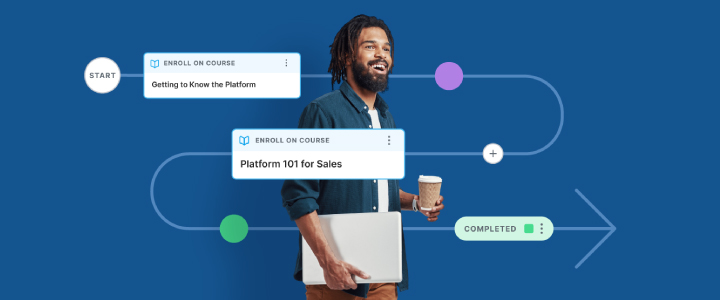
6 min reading time
10 Common Training Mistakes to Avoid
Every training program can run into problems. There’s nothing worse than spending precious time crafting the perfect course only to hit an unforeseen obstacle. A lot of trainers find themselves making the same mistakes over and over again – and sometimes without even realizing it. To train effectively you need to know what to avoid. This list of 10 common mistakes will help you run the most successful training programs possible.
1. Not looking before you leap
Creating an effective training program always starts with analysis. Take a step back and look at the situation as it currently stands. This gives you a foundation to build upon. L&D is always under the spotlight, particularly in terms of a return on investment. This is especially true if you were recently hired in your role. Resist the temptation to jump right in. Skipping the analysis stage is a bad idea. Be confident that this preparation will reap rewards in the future.
You should:
- Speak to all teams leads about current training.
- Get to know the challenges/barriers to effective training.
- Collect information on previous successes and failures.
- Ask for support and participation from colleagues.
- Decide your goals and objectives.
- Share findings to get buy-in.
Tip: Analyze..but avoid paralysis by analysis. Prepare well and accept that this is an iterative process.
2. Unclear goals or objectives
First things first, goals and objectives are not the same things! A learning goal is what the learner will be able to do once the course has been completed. A learning objective is a specific element that the learner will have mastered by completing the course.
Goals are broad. Objectives are specific.
You should be able to match overall needs to objectives. Needs dictate the goals, goals dictate the objectives and objectives dictate the assessment.
A goal is made up of a series of objectives. Let’s look at one example:
- Goal: Raise the standard of product knowledge
- Objective: All staff should know the 6 uses of the new feature
- Assessment: Create an exam with questions a customer may have in relation to this new feature
Using this basic model allows you to frame your thought process. Map it out on a whiteboard and use it to build your training programs.
3. Not considering practicalities
Once your goals and objectives are in place you need to temper it with a practical view. There is no point in creating a plan that isn’t feasible. Think about the time frame, budget, and resources at your disposal, and then decide what is achievable. Don’t let perfect get in the way of great.
Be pragmatic:
- How many courses can you create?
- Can you produce video-based courses?
- How many Instructor-led sessions can you run?
4. Doing it all yourself
During the analysis stage, you will have engaged with various team leads and managers. So here’s another opportunity to ask for help! Get subject matter experts to provide you or your team with the resources you need to create great content. Bring in colleagues to help you create the best courses. Some will love the opportunity to impart their knowledge, some won’t. Get as much input as you can.
Building courses can often be a process of repurposing existing materials. Ask for guides, docs, videos, anything that can be pulled into a course. When the courses are ready get your colleagues to pilot them before you make them available to the relevant staff. Once your colleagues get to see the impact of their involvement they may even play a bigger part in training in the future.
5. Cognitive overload

Overloading learners is the kiss of death. It can have a negative effect on engagement, completion, and also the uptake of future courses. Don’t waste your learner’s goodwill by providing them with impenetrable courses. That frustration is hard to undo. Take into consideration that a lot of courses are done when the learner has a free moment. A canceled meeting or during their commute. Split up content into manageable chunks. This helps with completion and retention.
A great course should match the attention span and availability of the user. Try to keep courses to a maximum of 15 – 20 minutes.
Tip: If you split content into manageable chunks, provide reminders of the significance of the content from a high level. These reminders could also contain a recap of what was covered in the previous section of the course.
6. Poor media choice
Choose the right media for your courses. We can all fall into the trap of defaulting to our favored media type. Some trainers have always used text-based courses. Evaluate the types of media you’re using so that you are giving the learner the best chance of taking in the information. Each media choice has its own strengths and weaknesses. And also varying levels of difficulty to create.
Let’s look at the various media used in eLearning:
- Text – Dense but excellent in providing context.
- Imagery – Communicates a lot of information in a short amount of time, but can lack context.
- Video – Rich media, high in information and context, but is more difficult to create.
- Presentations – Slide-based content, usually contains a combination of text, imagery, and video.
- Live session/Webinar – Excellent for creating a feedback loop, allows you to answer questions on the fly.
I would always recommend using richer media if possible.
There’s an abundance of tools available that allow you to create great presentations with video and audio included. For example, Soapbox is a browser plugin from Wistia that allows you to use your laptop webcam to create video content. It’s very accessible and the videos can be uploaded and hosted on Wistia in minutes. Those videos can then be embedded in your eLearning courses.
7. Poor user experience
Creating a positive experience for the learner should be a top priority. Learner engagement depends on a frustration-free experience. Step 1 is to use a learning management system (LMS) that’s easy for the learner to use. Step 2 is to think from the perspective of your learners. First impressions are important. Introduce them to the LMS, make it easy for them to engage with it and find their way around.
This can be achieved through a campaign-based approach. Send emails with screenshots of the user interface so they know what to expect. Cover the basics with them – how to log in, how to reset their password, where they can find the courses they need to complete, resources, etc. This groundwork helps adoption and streamlines the experience for the learner… and make your life easier in the long run.
Tip: This content can be reused as a guide for new hires!
8. Lack of encouragement
A successful eLearning program is run with a carrot or stick approach. For mandatory training such as compliance training, the stick is used far more often. The learner has to complete the task, and the manager must ensure it’s done.
For everything else, encouragement is more effective and less taxing to employ.
Encourage your users and highlight their success. Don’t let their cooperation and enthusiasms disappear into a vacuum. Gamification is an excellent way to reward progression and to create some healthy positive competitions. Make sure to highlight great performances and participation to positively reinforce the training program.
9. Failing to gather feedback
If you’re not listening to learners you’re ignoring the views of the most important people in the process. A failure to gauge their views results in your analysis missing an integral part. Create a way to gather feedback and set aside time to analyze it. Add surveys and ratings to courses to capture learner feedback.
See what works and what doesn’t. Don’t take it too personally. Implement changes in the next iteration of your courses.
Tip: Keep a record of these changes to prevent you falling back into bad habits.
10. No post-mortem

Look at the performance of each training course. That way you can learn from your efforts. Identify areas that need improvement. Did learners interact with the content in a timely fashion? Did a large percentage fail? Is the LMS being adopted? Take each post-mortem into your next stage of analysis. That arms you with the information you need to make informed changes in the next iteration.
Conclusion
Mistakes will still happen. Things will still go wrong. That’s life. Hopefully, this collection of mistakes to avoid is more than just that. It’s encouragement that the process is ongoing, every mistake is a learning opportunity and the process will get better and better. Let us know in the comments if there are other mistakes that have cropped up in your programs and how you overcame them.



